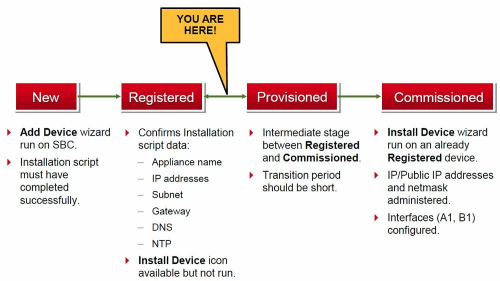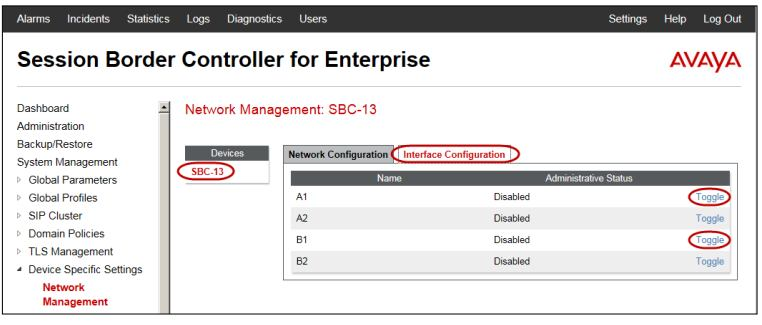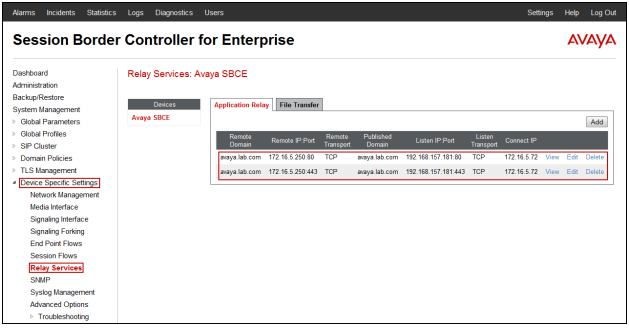Download Avaya Aura Communication Applications Integration Exam.7130X.CertDumps.2018-01-11.65q.vcex
| Vendor: | Avaya |
| Exam Code: | 7130X |
| Exam Name: | Avaya Aura Communication Applications Integration Exam |
| Date: | Jan 11, 2018 |
| File Size: | 2 MB |
How to open VCEX files?
Files with VCEX extension can be opened by ProfExam Simulator.
Discount: 20%
Demo Questions
Question 1
Before SIP Trunking configuration can begin, which state must the Avaya Session Border Controller for Enterprise (SBCE) be in?
- Registered
- Provisioned
- Commissioned
- Ready
Correct answer: C
Explanation:
Prerequisite Conditions for SIP Trunking Starting point for SIP-trunking administration:System Management > Installed tab shows SBC(s) Commissioned indicates a successful initial console configuration. References: Avaya Aura Session Border Controller Enterprise Implementation and Maintenance (2012), page 302 Prerequisite Conditions for SIP Trunking
Starting point for SIP-trunking administration:
System Management > Installed tab shows SBC(s) Commissioned indicates a successful initial console configuration.
References: Avaya Aura Session Border Controller Enterprise Implementation and Maintenance (2012), page 302
Question 2
After the initial provisioning script has been run you see your Avaya Session Border Controller for Enterprise (SBCE) displaying a Registered state in the Web GUI. You click on the install link in the EMS System Management > Devices menu to continue the installation.
After displaying a status of Provisioning for a short while, which status does the SBCE display?
- Commissioned
- Up
- Busyout
- Maintenance-Busy
Correct answer: A
Explanation:
SBC states: References: Avaya Aura Session Border Controller Enterprise Implementation and Maintenance (2012), page 201 SBC states:

References: Avaya Aura Session Border Controller Enterprise Implementation and Maintenance (2012), page 201
Question 3
From a remote worker’s SIP Endpoint connected via Mobile Workspace, which tool is used to trace the successful way through Avaya Session Border Controller for Enterprise (SBCE) of an Invite message?
- traceRT
- traceSM
- traceMW
- traceSBC
Correct answer: B
Explanation:
traceSM is an interactive perl script that allows an administrator to capture, view, and save call processing activity on a Session Manager. While not as powerful or versatile as wireshark, traceSM is absolutely essential when it comes to working with Avaya SIP. First off, it allows you to view SIP messages even if they have been encrypted with TLS. Incorrect Answers:D: traceSBC is a Perl script that is run from a PuTTY or TuTTY session connected to the SBC’s Management (M1) IP address. It is used to monitor sessions.References: https://andrewjprokop.wordpress.com/2014/06/02/a-necessary-guide-to-the-avaya-tracesm-utility/ traceSM is an interactive perl script that allows an administrator to capture, view, and save call processing activity on a Session Manager. While not as powerful or versatile as wireshark, traceSM is absolutely essential when it comes to working with Avaya SIP. First off, it allows you to view SIP messages even if they have been encrypted with TLS.
Incorrect Answers:
D: traceSBC is a Perl script that is run from a PuTTY or TuTTY session connected to the SBC’s Management (M1) IP address. It is used to monitor sessions.
References: https://andrewjprokop.wordpress.com/2014/06/02/a-necessary-guide-to-the-avaya-tracesm-utility/
Question 4
The provisioning script automatically runs as part of the first boot-up of the Avaya Session Border Controller for Enterprise (SBCE). During this process you assign the Management IP address to the SBCE. You browse to the Element Management System (EMS) to continue to install the SBCE.
On the System Management > Devices web page, which status does the SBCE display before the Install link is clicked?
- Ready
- Provisioned
- Registered
- Commissioned
Correct answer: C
Explanation:
References: Avaya Aura Session Border Controller Enterprise (2012), page 201 
References: Avaya Aura Session Border Controller Enterprise (2012), page 201
Question 5
To watch Avaya Session Border Controller for Enterprise (SBCE) messages in real time as they pass through the SBCE, which tool on the SIP command line do you use?
- traceSBC
- traceSM –m
- traceTOOL
- trace
Correct answer: A
Explanation:
The tcpdump tool is the main troubleshooting tool of Avaya SBCE, which can capture network traffic. Using tcpdump is a reliable way to analyze the information arriving to and sent from the SBC. However, tcpdump has its own limitations, which can make troubleshooting difficult and time consuming. This traditional tool is not useful in handling encrypted traffic and real-time troubleshooting. The traceSBC tool offers solutions for both issues. In Real-time mode, traceSBC must be on active Avaya SBCE. traceSBC is started without specifying a file in the command line parameters. The tool automatically starts processing the log files. The live capture can be started and stopped anytime without affecting service. Example:# traceSBC References: Troubleshooting and Maintaining Avaya Session Border Controller for Enterprise (December 2015), page 27https://downloads.avaya.com/css/P8/documents/101014063 The tcpdump tool is the main troubleshooting tool of Avaya SBCE, which can capture network traffic. Using tcpdump is a reliable way to analyze the information arriving to and sent from the SBC.
However, tcpdump has its own limitations, which can make troubleshooting difficult and time consuming. This traditional tool is not useful in handling encrypted traffic and real-time troubleshooting.
The traceSBC tool offers solutions for both issues.
In Real-time mode, traceSBC must be on active Avaya SBCE. traceSBC is started without specifying a file in the command line parameters. The tool automatically starts processing the log files. The live capture can be started and stopped anytime without affecting service.
Example:
# traceSBC
References: Troubleshooting and Maintaining Avaya Session Border Controller for Enterprise (December 2015), page 27
https://downloads.avaya.com/css/P8/documents/101014063
Question 6
On Avaya Session Border Controller for Enterprise (SBCE), which two ways can be used to view System Logs? (Choose two.)
- from CLI execute cat > var > log > Avaya > syslog
- from System Manager web GUI > Alarms and Events
- from CLI execute cat archive > syslog > ipcs.log
- from EMS web GUI SBCE Dashboard access Logs > System Logs
Correct answer: CD
Explanation:
C: Call Trace data are written to this location:– /archive/syslog/ipcs/octeon.log D: Viewing system logsProcedure Log on to the EMS web interface with administrator credentials. Select the Logs option from the toolbar, and click the System Logs menu. The system displays the Syslog Viewer screen. On this screen, you can specify criteria in the Query Options section to filter the results displayed. In the Start Date and End Date fields, filter the results displayed in a search report to fall within starting and ending dates and times. In previous Avaya SBCE Syslog Viewer windows, there were four separate fields: Start Date, Start Time, End Date, and End Time.References: Troubleshooting and Maintaining Avaya Session Border Controller for Enterprise (December 2015), page 21Avaya Aura Session Border Controller Enterprise Implementation and Maintenance (2012), page 478 C: Call Trace data are written to this location:
– /archive/syslog/ipcs/octeon.log
D: Viewing system logs
Procedure
- Log on to the EMS web interface with administrator credentials.
- Select the Logs option from the toolbar, and click the System Logs menu.The system displays the Syslog Viewer screen. On this screen, you can specify criteria in the Query Options section to filter the results displayed.
- In the Start Date and End Date fields, filter the results displayed in a search report to fall within starting and ending dates and times. In previous Avaya SBCE Syslog Viewer windows, there were four separate fields: Start Date, Start Time, End Date, and End Time.
References: Troubleshooting and Maintaining Avaya Session Border Controller for Enterprise (December 2015), page 21
Avaya Aura Session Border Controller Enterprise Implementation and Maintenance (2012), page 478
Question 7
In the Avaya Session Border Controller for Enterprise (SBCE), before a traffic carrying Network Interface (A1 or B1) can be pinged, to which state do you have to toggle the status on Device Specific Settings > Network Management / Interfaces?
- Enabled
- In-Service
- Accept Service
- Active
Correct answer: A
Explanation:
Commission the SBC—SBC Configuration 1. The A1 and B1 interfaces display on the Network Configuration tab: 2. Click on the Interface Configuration tab: 3. Click the Toggle link for both the A1 and the B1 interfaces. The Administrative Status for both A1 and B1 changes to Enabled: References: Avaya Aura Session Border Controller Enterprise Implementation and Maintenance (2012), page 203 Commission the SBC—SBC Configuration
1. The A1 and B1 interfaces display on the Network Configuration tab:

2. Click on the Interface Configuration tab:

3. Click the Toggle link for both the A1 and the B1 interfaces.
The Administrative Status for both A1 and B1 changes to Enabled:

References: Avaya Aura Session Border Controller Enterprise Implementation and Maintenance (2012), page 203
Question 8
How many Server Flows and/or Subscriber Flows are required for SIP Trunking?
- one Subscriber Flow and two Server Flows
- a minimum of two Subscriber Flows
- one Subscriber Flow and one Server Flow
- a minimum of two Server Flows
Correct answer: A
Explanation:
Two types of flows need to be defined for the proper routing of SIP messages from and to the endpoints and the SIP server. Server Flows – Routing destination sent by SIP server (Session Manager). Subscriber Flows – Routing destination sent by SIP endpoints. Example, Server Flows: References: Avaya Aura Session Border Controller Enterprise Implementation and Maintenance (2012), page 540, 546 Two types of flows need to be defined for the proper routing of SIP messages from and to the endpoints and the SIP server.
- Server Flows – Routing destination sent by SIP server (Session Manager).
- Subscriber Flows – Routing destination sent by SIP endpoints.
Example, Server Flows:

References: Avaya Aura Session Border Controller Enterprise Implementation and Maintenance (2012), page 540, 546
Question 9
In Avaya Session Border Controller for Enterprise (SBCE) 7.x, you need to download the 46xxsettings.txt file to a Remote Worker device.
What needs to be configured under DMZ Services > Relay Services?
- Application Relay and File Transfer
- Reverse Proxy
- Application Relay
- Application Relay and Reverse Proxy
Correct answer: C
Explanation:
Relay Services are used to define how file transfers (e.g., for phone firmware upgrades and configuration), are routed to the Remote Worker endpoints. Example: 2 For accessing the file server using HTTPS protocolThe following screenshot shows the newly created Relay Services References: Configuring Remote Workers with Avaya Session Border Controller for Enterprise Rel. 6.2, Avaya Aura Communication Manager Rel. 6.3 and Avaya Aura Session Managers Rel. 6.3 - Issue 1.0, page 73 https://downloads.avaya.com/css/P8/documents/100183254 Relay Services are used to define how file transfers (e.g., for phone firmware upgrades and configuration), are routed to the Remote Worker endpoints.
Example: 2 For accessing the file server using HTTPS protocol
The following screenshot shows the newly created Relay Services

References: Configuring Remote Workers with Avaya Session Border Controller for Enterprise Rel. 6.2, Avaya Aura
Communication Manager Rel. 6.3 and Avaya Aura Session Managers Rel. 6.3 - Issue 1.0, page 73
https://downloads.avaya.com/css/P8/documents/100183254
Question 10
When planning the Avaya Session Border Controller for Enterprise (SBCE) for SIP Trunking, what is a good practice to adopt?
- Name Interfaces consistently, for example, A1 for Internal network to Call Server and B1 for external to Trunk Server.
- Name all internal and external interfaces exactly the same.
- Use the same IP address on both, internal and external sides of the network.
- Use one Avaya Session Border Controller for Enterprise on the internal and external sides of the network.
Correct answer: A
Explanation:
Use the same interface mapping throughout! Examples in this section use:A1 as the internal interface (to the call server) B1 as the external interface (to the trunk server) References: Avaya Aura Session Border Controller Enterprise Implementation and Maintenance (2012), page 304 Use the same interface mapping throughout! Examples in this section use:
- A1 as the internal interface (to the call server)
- B1 as the external interface (to the trunk server)

References: Avaya Aura Session Border Controller Enterprise Implementation and Maintenance (2012), page 304
HOW TO OPEN VCE FILES
Use VCE Exam Simulator to open VCE files

HOW TO OPEN VCEX AND EXAM FILES
Use ProfExam Simulator to open VCEX and EXAM files


ProfExam at a 20% markdown
You have the opportunity to purchase ProfExam at a 20% reduced price
Get Now!



